First off, you may want to select a switch that provides tactile and visual cues that make sense to you. I'll provide two examples:
In the latter case, not listed in the datasheet there but available, is the TJ mounting frame which includes two LEDs you can use, if you want that.
Regardless, once you've selected the switch it is just a matter of finding two relays that are DPDT (double-pole, double-throw) devices:

simulate this circuit – Schematic created using CircuitLab
Above, the LO and HI switches shown are really just two parts the same switch: one of them being one side of one pole, the other of them being the other side of the other pole. It isn't possible for you to turn both of them ON at the same time because of the switch design, so the above circuit doesn't protect against that impossibility.
I just threw this together between bouts of sleep, so I will check this over better tomorrow. But I figured I'd put it out there for your consideration and to allow others to check the work and complain, if they see a problem above.
New day.
The earlier schematic was more of a wiring diagram. The following is more of a conceptual (for purposes of understanding it) diagram:

simulate this circuit
(When reading this one, keep in mind that both relays cannot be simultaneously activated. Also, I removed the two diodes to aid clarity.)
On the left side, when both relays are inactive then both sides of the BACK and CUSHION heaters are grounded and the middle node is left floating. So no power is applied to them and they are galvanically tied at both ends to the vehicle's ground.
When the LO relay is active, then the BACK and CUSHION heaters are connected in series between \$+12\:\text{V}\$ and the vehicle ground, so that they present a high impedance and therefore lower power is applied to them, as is appropriate in this case.
When the HI relay is active, then the BACK and CUSHION heaters are connected in parallel, applying \$+12\:\text{V}\$ to the center node while both opposing ends are at the vehicle ground, so that they present a combined low impedance and therefore higher power is applied to them, as is again appropriate in this other case.
The right side has three states:
- Both relays OFF: In this state, the LO relay is tied at one end (through the inactive \$S_2\$ state of the HI relay) to the vehicle ground. Meanwhile, the LO momentary switch tied to \$+12\:\text{V}\$ so that, when pressed momentarily, it can actively supply power to the LO relay. Similarly, the HI relay is tied at one end (through the inactive \$S_2\$ state of the LO relay) to \$+12\:\text{V}\$. Meanwhile, the HI switch is tied to the vehicle ground so that, when pressed momentarily, it can actively supply power to the HI relay. In short, either relay can be activated, depending on which way the HI/LO momentary DPST switch is pressed.
- LO relay is ON: In this state, power is continuously supplied to the LO relay via \$S_2\$ of both relays. The momentary switch can return to its center position and the LO relay remains powered.
- HI relay is ON: In this state, power is continuously supplied to the HI relay via \$S_2\$ of both relays. The momentary switch can return to its center position and the HI relay remains powered.
When vehicle power is removed, both relays also become unpowered and the system returns to its unpowered state where it will remain when vehicle power is returned and the circuit can be used again.
Hopefully, that helps clarify the design a bit.
The idea is missing one detail. Once LO is activated, the HI mode is unavailable. Similarly, once HI is activated, the LO mode is unavailable. (By design. I intended it when I was laying this out.) A simple solution I'd considered is to add a series momentary SPST (normally closed) between the actual vehicle \$+12\:\text{V}\$ and the \$+12\:\text{V}\$ rail used in the flip-flop portion of the circuit. Pressing the button would open this switch, releasing the relays and returning the rocker switch to select a new mode, if desired.
If you want that feature, add the normally-closed momentary SPST RESET switch as shown at the top of the schematic below:

simulate this circuit
That will emulate the effect of turning the vehicle off, resetting both relays.
Don't forget the fuse that was indicated in your original schematic!



